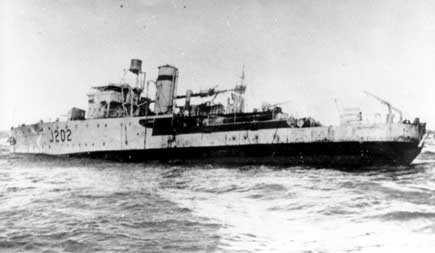- Author
- Howland, Tony
- Subjects
- Ship histories and stories
- Tags
-
- RAN Ships
- HMAS Warrnambool I, HMAS Swan II, HMAS Voyager I
- Publication
- September 2007 edition of the Naval Historical Review (all rights reserved)
This story was compiled by Tony Howland from several websites, including primarily HMA Ship Histories by the Sea Power Centre – Australia, and Shipwrecks by the ABC.
HMAS Warrnambool (1) was one of sixty Australian minesweepers (commonly known as corvettes) built during World War II in Australian shipyards as part of the Commonwealth Government’s wartime shipbuilding programme. Twenty were built on Admiralty order but manned and commissioned by the Royal Australian Navy. Thirty-six (including Warrnambool) were built for the Royal Australian Navy and four for the Royal Indian Navy.
Warrnambool commissioned at Sydney on 23 September 1941 under the command of Lieutenant Eric J. Barron RANR(S).
After completing her trials, Warrnambool was immediately engaged in patrols in Bass Strait. After a couple of months, she traveled north and was present at Darwin when the first Japanese air raid occurred on 19 February 1942, but sustained no damage or casualties. The following day, the ship rescued 73 survivors of the Filipino merchant ship Don Isidron which had been attacked and set on fire by Japanese dive bombers. During the rescue operation, Warrnambool was bombed by a Japanese flying boat, but without damage or casualties.
In the first twelve months of Warrnambool’s commission, all except the first three of which were spent in northern waters, the ship had carried out five evacuations or rescue trips, been present during 18 air raids, and ferried 4,000 troops in New Guinea. In July 1942, in company with HMAS Southern Cross, she carried Netherlands East Indies troops and stores from Darwin to Dobo, in the Aru Islands. In September 1942 Warrnambool rescued survivors of the force from Dobo.
Later in September the ship assisted in the rescue of personnel of HMAS Voyager, which had grounded at Betano on the southcoast of Timor whilst landing Australian troops, and subsequently became a total loss.
Late in 1942 Warrnambool transferred to the Australian east coast and spent most of the remainder of the war operating in that area on anti-submarine patrols and convoy protection. Late in September 1944, she proceeded to Fremantle where she was based until the end of February 1945. Warrnambool then transferred to Darwin where she was based for the remainder of 1945.
Following the cessation of hostilities, Warrnambool was present at the Japanese surrender at Koepang, Timor, on 11 September 1945.
In her post-war career Warrnambool was primarily involved in mine clearance work in the Solomons and New Guinea areas, followed by similar operations in the Great Barrier Reef area. In September 1947 she was part of a mine sweeping flotilla working near Cape Grenville off Cairns.
At about 1600 on Saturday, 13 September, the flotilla was hard at work. A group of corvettes was trailing the larger sloop, HMAS Swan, along the edge of Cockburn Reef. Each ship was slightly to port of the one ahead, trailing their sweeps to port.
Whether Swan snagged a coral obstruction, or fouled a mine, her Oropesa float dipped suddenly and the sweep snapped. Warrnambool’s immediate response was to swing hard to starboard, tucking in astern of Swan and into, hopefully, swept water. They fully expected their sweep to snag on the same obstruction.
Instead, they struck a mine.

(Image: Seapower Centre)
Perhaps Swan had loosed the mine from its mooring. Perhaps she had simply missed it, lucky to pass by without touching it.
The British Mk 14 mine carries 500 lbs of mineol explosive and the effect on Warrnambool was terrible.
1600 was of course the time for change of watches. Of the nearly 70 men on board, many were in the mess, directly above where the mine hit. Those below the waterline, in and around the engine room, took the brunt of the blast. One of the stokers was fatally injured when one of the lockers tore free and crushed his chest. Men in the heads were badly injured, slammed into the deckheads before crashing down to smash the porcelain bowls.
Topside, those on deck were lifted metres into the air as the bow section was lifted completely out of the water. On the bridge, the officer of the watch was blown through the glass bridge screen and up towards the bow. A signalman was thrown from the bridge into the sea and never seen again. Shards of glass and the concussion left the Captain unconscious.




